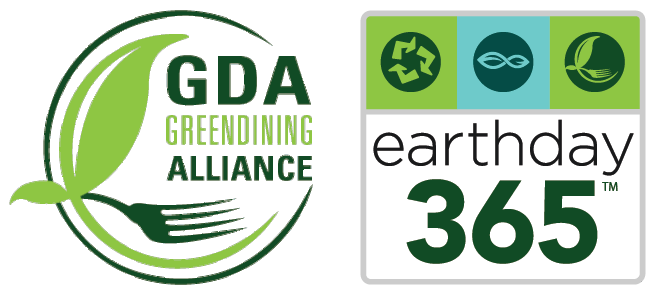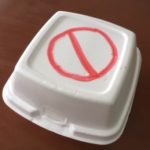Written and published March 2016 by Olivia Engel, Green Dining Alliance Program Coordinator
Those little recycling arrows on the bottom of plastic disposables may give you the feeling that all plastics are recyclable and created equal. But the logistics behind manufacturing, collecting, and recycling plastics are a bit more complex.
Fortunately, there are plenty of environmentalist nerds out there – like us – to cut through the clutter for you.
We’ve compiled a some research here so that you can have a better understanding of the materials around you and your food, and know how to make the best choices for the environment and public health.
“Good” or “Bad”?
Since there are a lot of plastics to keep straight, take some tools for discerning what’s “good” or “bad” around with you when you shop or eat. Discernment tools empower your choices. When you have a toolkit of knowledge and easy-accessible resources, you have the opportunity to better understand the things you buy to make choices that reflect your values and keep you and your planet healthy.
So what do those little numbers mean?

(Mike Bitzenhofer – flickr – https://www.flickr.com/photos/bitzcelt/)
There are 7 numbers signifying different types of plastics – and there are also a few varieties that fall under each number.
Some municipalities have recycling centers that can process most plastics while a neighboring city can only process some. For example, many haulers will “accept” #6 plastic (polystyrene), but since it is a low-grade, low-quality plastic, it is likely that the plastic will not end up with a second life, instead winding up in a distant landfill.
Recycling in St. Louis has changed a lot from just ten years ago: for example, you no longer have to wash out your recyclables – just ensure they are empty.
For a complete, easily understandable list of recyclable products, take a look at this graphic developed by the GDA’s sister program Recycling On the Go:
The Eco-cycle pocket guide to plastics is another useful tool to identify recyclables while out and about. Folded up in your wallet or purse, or tacked onto the bulletin board above your office desk or recycling bin, this little piece of paper will quickly feel like a friend when you are faced with purchasing or disposal decisions.
From scum to savings
Buying higher quality plastics or avoiding them whenever possible can get expensive. Although they are more expensive, the investment in your health and the environment is worth the additional costs. Sustainable options are usually more expensive because Styrofoam and other cheap plastics are subsidized, deflating their market price to an illusory low. The hidden prices of exploitation, pollution, and negative impacts on human health are not factored into their price tags.
Here are some ways to offset the costs of purchasing more expensive, sustainable products while supporting the green economy:
-
Save on utility bills: Do you know how much of your money is sucked up by lighting alone? Switching to LEDs saves about 8 times the energy in lighting and about 10% on your heating bill in the summer (and right now, there are rebates available from Ameren BizSavers for this upfront cost). Look into flow flush toilets, and be sure aerators are on every sink. The little things really do add up: even fixing a leaky faucet can save you around $100/year.
-
Use fewer disposable materials: Throwing away less means less purchasing and less hauling. The upfront cost involved in purchasing reusables will pay off over time – and in restaurants, the improved aesthetic quality of your meals may not be measurable in dollars, but customers can feel the difference. Reducing your plastic consumption is far better for the environment than recycling purchased plastics.
-
Buy in bulk: Reduce your price per item and your trash by buying in larger quantities. Avoid individually-wrapped products or small bottles when larger ones are available. Packaging is responsible for about 40% of our waste stream -remember to reduce the waste you generate whenever possible!
-
Prioritize your choices: Not every green option is affordable for you, or even makes practical sense for your home or business. Take a look at your top priorities for public and environmental health, and take stock of your resources. Chances are you can’t make every single sustainable decision from the get-go, but every step, every action helps.
A drop in the ocean?
There is an argument – we’re sure you’ve heard it – that there is just too much going on in the world for any individual to make a difference.
To this argument we say: every individual adds up to the whole. While it’s true that industry is by far the biggest driver behind climate change and pollution, it’s also true that every time you make a choice with your pocketbook, you’re essentially voting for what you want to see in the market and world. You also have more influence than you think – you’re friends and family are more likely to commit to sustainability when they see someone they love and respect working towards a greener future.
Lead by example, and know that you are making a difference every day, with every purchase.



